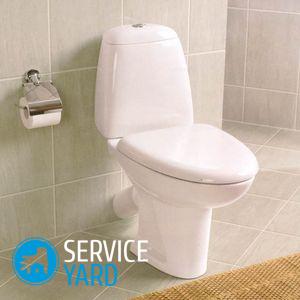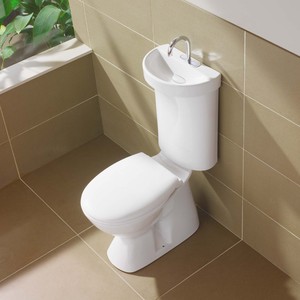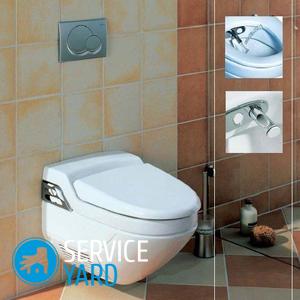Installing a toilet in a cast-iron sewer

If the plumbing worked properly, without failing, then life would be much simpler. But what about a sudden breakdown, how to install a toilet in a cast-iron sewer? Calling the wizard is the easiest way, but if you want and the availability of tools, you can do this work yourself. There is nothing particularly complicated about this. And to help you with this, in this article we will consider the procedure for performing such work.
to contents ↑Connection options
There are 3 types of drain pipe outlet:
- Horizontal.
- Squint.
- Vertical.
Talking about which of these options is better or worse would be somewhat incorrect. Much depends on when the building was built. Previously, the most common was oblique drainage, and nowadays, modifications with horizontal drainage are becoming popular.
to contents ↑Important! The correct choice of the type of toilet, in strict accordance with the method of withdrawal of drains - this is the main thing in the purchase. If this is not taken into account, you will either have to return to the store, or on the go invent a way to connect the toilet to the sewer.
Connection Methods
There are 3 varieties of connecting the toilet to the sewer:
- Fan pipes.
- Cuff eccentric.
- Corrugated pipe.
For old cast-iron pipes, the use of rubber cuffs is considered the best option. To make the connection as tight as possible, use a sealant.
Fan pipes make the connection beautiful. The use of porcelain and earthenware parts creates the effect of a single design.
Important! The only disadvantage of using a fan pipe is the need for an accurate fit of the parameters of the drain pipe and toilet outlet, since nothing can be cut or bent here.
For the manufacture of eccentric cuffs, polymeric materials are used. These are 2 pipes of various lengths with axes displaced relative to each other. The main advantage of mounting on an eccentric is its versatility. With their help, you can easily connect toilets of various kinds.
The advantage of a corrugated pipe is that it can stretch and bend. This greatly simplifies installation. The only thing you need to take care of is the right choice of the angle of the pipe and its good quality.
to contents ↑DIY connection of a toilet to a sewer: tools for work
To connect the toilet to the sewer, you will need the following tools:
- Wrenches of various sizes.
- Hammer or drill.
- Hammer.
- Screwdriver.
- Clerical knife.
- Roulette.
- Hacksaw for metal.
- Adjustable wrench.
- Gypsum putty, cement.
- Sealant.
- Sandpaper.
Corrugated Pipe Application
This universal method is used when other connection methods are ineffective:
- Turn off the water supply.
- Insert one end of the corrugated pipe into the drain.
- For sealing use any sealant, preferably silicone.
- Put the other end of the pipe on the toilet outlet, also using sealing materials.
- Now resume the water supply, wait until the tank is full, and drain the water.This is a kind of testing of the assembled design for the absence of leaks.
- Screw the toilet to the floor with dowels and screws.
Important! To simplify the work and accurately drill holes, mark the places for holes on the floor with a marker.
- After the toilet is fixed, check it for stability.
Important! Do not forget that silicone sealant needs some time to gain the necessary strength.
Now consider a few options for installing a toilet without corrugation.
to contents ↑Installation of plumbing with vertical outlet
This type of plumbing is most often found in new homes. The model is equipped with a siphon and a vertically oriented outlet:
- First mark the place where the drains are discharged.
- Using the special clips, fasten the screw flange.
- Insert the sewer pipe in the center of the flange, and put the toilet bowl on top.
- Turn it so that it is firmly fixed.
Important! The main advantage of this design is aesthetics and elegance. Sewer wiring is not visible, this creates the impression of a free, uncluttered space.
The downside of the vertical release is low maintainability. If repairs are needed, you need to dismantle the floor, under which the wiring of the plumbing is located.
to contents ↑Installing a toilet with a horizontal outlet
In this case, the drain is discharged in a horizontal direction, “to the wall”. When installing plumbing with a horizontal outlet, sealing cuffs are used. First, the plumbing is fixed to the floor, and then connected to the sewer.
to contents ↑Important! The advantage of this option of mounting the toilet to the sewer is its simplicity and the ability to perform all installation work independently. Minus - limited scope, the presence of only a vertical riser.
Connecting a toilet with an oblique outlet to the sewer
The correct installation of plumbing with an oblique outlet has certain features:
- Prepare a mixture of meerkat and drying oil. Lubricate the toilet pipe with this compound.
- Wrap a resin seal over the nozzle, leaving the edge of the nozzle free and greased with minium.
- Lock the toilet hole in the sewer pipe.
- Mount the toilet.
Important! The described method is considered convenient and reliable. When installing a toilet with an oblique outlet to a cast-iron sewer, it sometimes happens that the hole is too large, and the rubber cuff to close it is clearly not enough. In this case, use cement mortar to seal. Do not forget to make sure that the mortar does not get into the riser.
Sometimes it turns out to use a rubber cuff for sealing. In this case, thoroughly clean the surfaces and do not spare the sealant.
to contents ↑Stock footage
Do not be afraid to carry out installation work yourself. Practice shows that there is nothing particularly complicated in them, and saving money is quite significant.








